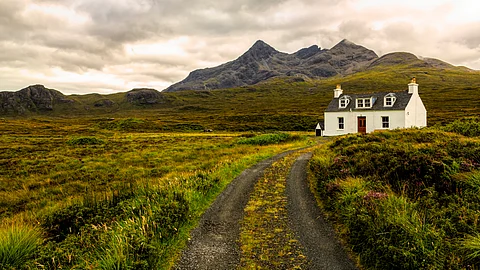
- Destinations
- Experiences
- Stay
- What's new
- Celebrating People
- Responsible Tourism
- CampaignsCampaigns
- SubscribeSubscribe
- Buy Now

In all of Europe, there's hardly a place that holds a candle to the compelling cluster of travel experiences that the Scottish Highlands offer. Stretching from the far reaches of the northwest to the edge of the Central Belt, a traveller can expect an inexhaustible supply of evocative mountains, lochs and islands with history to go with it.
For travellers in search of something profound, contemplative and reflective, the Highlands are just the destination, replete with the treasures of time and terrain. Here, we will show you why this region deserves to be on every serious traveller’s itinerary.
Some of the most majestic and ancient landscapes in the British Isles form the salubrious Scottish Highlands. This magnetic topography was shaped by volcanic activity and glaciation over millions of years. Glen Coe, widely taken as one of Scotland's most scenic glens, is encircled by jagged peaks and steep valleys. The deep, dark waters of Loch Ness, at once mythical and mesmerising, plunge over 200 m across the Great Glen Fault. Nearby, Loch Shiel, accompanied by its backdrop of the Glenfinnan Monument, forms a cinematic and historically charged vista. On the west coast, the rugged outline of sea lochs and windswept beaches commingle to create a coastline that is as wild as it is beautiful.
Every valley and castle in the Highlands hold such immense heft of the past that you may envision it to be the backdrop of Scooby Doo episodes. The region is steeped in the traditions of the Gaels, Picts and Celts; once, it was ruled by the iron hand of clans whose legacies still linger in everything from tartan patterns to regional surnames. The battlefield of Culloden near Inverness is particularly striking on the Scottish map as it's where Bonnie Prince Charlie’s Jacobite army was defeated in 1746.
Furthermore, the massacre at Glencoe in 1692, when members of the MacDonald clan were slain by guests they had hosted—a plot that sounds like one of Shakespeare’s yarns—continues to haunt local memory. Travellers can also explore Kilmartin Glen, where more than 350 ancient monuments—standing stones, burial cairns and rock carvings—span over 5,000 years of history. Castles like Eilean Donan, set against fjord-like scenery, symbolise both Scotland’s martial past and architectural resilience.
The Highlands are undoubtedly one of Europe's last surviving vestiges of wilderness. Home to species like red deer, golden eagles, pine martens, otters and mountain hares, the region makes for a great locale to exercise your penchant for wildlife photography.
In the Cairngorms National Park, you stand to witness rare species such as the capercaillie and Scottish wildcat that still survive. In addition, coastal areas, too, are to be considered no less in terms of wildlife. Here, grey seals, dolphins, porpoises and even minke whales that are regularly sighted along the western shores lend colour to the landscape. Curated wildlife tours offer guided access to the most rewarding viewing locations that do not disturb conservation practices. For those drawn to the rawness of nature, the Highlands deliver unfiltered encounters with animals, positively unmediated by the human hand, with the animal world in its pristine habitat.
The Highlands are central to the long-celebrated whisky identity of Scotland. With legendary distilleries such as Glenlivet, Macallan, Talisker and Glenmorangie, the Highlands are where you can take guided tours and sample these poisons. The region's diverse terrain—from coastal Skye to the Speyside Valley—produces a wide range of flavour profiles, from peaty and smoky to floral and light.
Whisky trails are now popular with both connoisseurs and casual travellers, forming intoxicatingly scenic routes through glens and coastal hamlets. Highland cuisine, in turn, has only been gaining more and more acclaim, supported by Michelin-starred restaurants and celebrated chefs behind them. Locally sourced lambs, beef and game feature prominently, as do sea specialities like scallops, langoustines and mussels. In addition, traditional spreads like haggis, black pudding and cranachan reflect the region's agricultural heritage.
The Highlands are quite the playground for those with a taste for the great outdoors. Climbing Ben Nevis, Britain's tallest mountain at 1,345 m, is a rite of passage for hikers. The region's lochs, rivers and coastal waters invite plenty of activities such as kayaking, fishing and wild swimming. The North Coast 500—a pleasant driving loop covering over 800 km—has come to be one of the United Kingdom's most iconic road trips. Rail enthusiasts can board the West Highland Line, often voted the most scenically rewarding railway journey in the world, which includes the famed Jacobite Steam Train, emblematic of "Harry Potter," whose route goes from Fort William to Mallaig.
Beyond the activities, ensure you commingle with the local people who leave a lasting impression. Highlanders are renowned for their folksy warmth, hospitality and generosity. Whether you're chatting in a local pub, attending a cèilidh (social gathering) or staying in a family-run inn, you'll likely leave with more than just memories—perhaps even a story or two worth retelling in a gathering.
